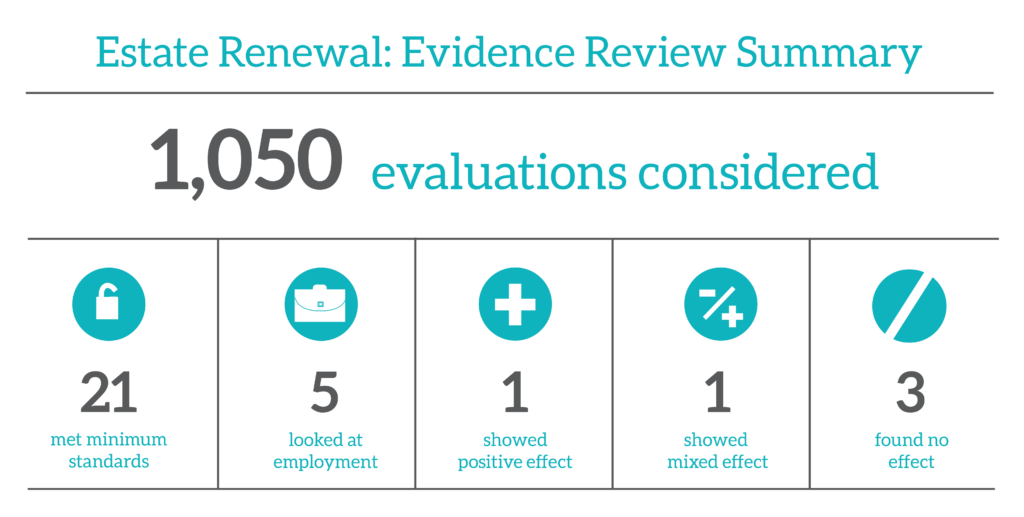Evidence review (PDF) published in January 2015.
Estate renewal provides housing and amenity benefits. However, the evaluation evidence finds their economic impacts are limited.
What is estate renewal?
Estate renewal refers to area based programmes that improve the housing stock, the built environment, and other local amenities with the aim of improving outcomes for local residents.
Estate renewal includes:
- Refurbished, demolished, demolished-and-rebuilt or built properties
- Area based interventions that include an element of physical regeneration
The rationale: How does estate renewal deliver growth?
Estate renewal is part of the broad policy approach known as ‘regeneration’. Regeneration programmes seek to improve social, economic, or physical conditions for a place and its residents.
Improvements to the physical environment may have a local economic impact by:
- Increasing incomes or employment, either directly due to improvements for existing residents or indirectly by changing the composition of the area;
- Improving other area outcomes such as crime; or
- Raising property values – either directly through property-specific improvements or indirectly through to area-level improvements.
Government intervenes in estate renewal where the market is unwilling to do so, as the private benefits generally do not outweigh the private costs of investment, or there is a high degree of uncertainty about the returns on investment.
Evidence review: What does the evidence say about estate renewal?
Our estate renewal evidence review considered almost 1,050 policy evaluations and evidence reviews from the UK and other OECD countries. It found 21 impact evaluations that met our minimum standards.

Evidence on impact and effectiveness is a crucial input to good policy making. In the case of estate renewal, the main aims are to improve the quality of housing, rather than to grow the local economy. But policy makers often claim economic benefits for these interventions and so economic impact evaluation is important to understand if these claims are justified. The finding of little local economic impact should not overshadow the other housing and amenity benefits that come from estate renewal.
What the evidence showed:
- Estate renewal programmes lead to increases in property and land prices and rents, although not necessarily for nearby properties that do not directly benefit from improvements.
- Estate renewal programmes tend to have a limited impact on the local economy in terms of improving income or employment.
- Estate renewal programmes tend to have a limited impact on the local area in terms of reducing crime, improving health, wellbeing or education.
The evidence suggests that whilst estate renewal projects may increase property prices, their measurable economic impacts on local economies in terms of employment, wages or deprivation tend not to be large and are often zero.
Where there was lack of evidence:
- We found no impact evaluations that isolated effects for existing residents. This means that the impacts above may be explained by changes in the composition of the neighbourhood (perhaps area-level incomes increase because richer households move in).
- There is little evidence on characteristics of schemes that might improve effectiveness or influence particular aspects of the local economy.
Lessons:
- Economic benefits are not the prime justification for estate renewal programmes, but they are often cited as a benefit in the policy-making process.
- As would be expected, investment does increase property prices. However, the impact on the wider economy tends to be small or zero.
- It’s also important to distinguish carefully between effects on the local area and benefits to existing residents (who may be temporarily or permanently displaced as a result of estate renewal).
Downloads:
Case studies: Advice on how to evaluate estate renewal
The main challenges to evaluating the local economic growth effects of estate renewal include:
- Estates are not chosen randomly for renewal programmes – policymakers may choose particularly distressed locations, or locations which they hope have strong regeneration potential. If this is the case, underlying trends for these areas need to be disentangled from any project effect.
- Estate renewal programmes may involve a degree of residential relocation. Residents may be required to move away for demolition works to proceed, or they may be compelled to move away due to increased housing costs. This adds a layer of complexity to any policy evaluation, since if we want to fully understand the impact on individuals then displaced individuals must be tracked. If studies do not track individuals but look at area-level effects, it can be difficult to understand the impact of projects. Increased area-level wages, for example, may be due to a positive effect on wages or may result because low income households have moved away to be replaced by higher income households.
- Multiple observations are required in order to form the treatment and control groups and estimate a ‘treatment effect’. It is unlikely that an individual local authority would have sufficient projects to allow robust impact evaluation (although collections of local authorities may be able to do so).
To help improve evaluation of estate renewal, we have two case studies that give examples of how previous policies have been evaluated.
Each evaluation case study has met our minimum standard of evidence, which means it (at a minimum) compares what changed for the places, businesses or individuals that benefited from an intervention with what changed over the same time frame for otherwise comparable places, businesses or individuals that didn’t benefit, or that received a different type of intervention. Both case studies use statistical approaches to try to ‘strip out’ the impact of the other factors that could have affected outcomes in both the beneficiary group affected by the renewal programme and the comparator group.
Read more about how to evaluate, and why we think it can be helpful to learn from previous approaches in our how to evaluate guide. You can also read more about different evaluation methods in our scoring guide.




